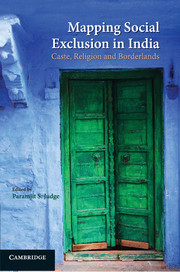Book contents
- Frontmatter
- Contents
- List of Tables and Figures
- Preface
- Introduction
- Part I Social Exclusion in India: Perspectives and Issues
- 1 Inequality, Poverty and Social Exclusion in India
- 2 Social Exclusion, Globalization and Marginalized Groups
- 3 Situating Social Exclusion in the Context of Caste: A Case of Dalits in India
- 4 Reservation Policy in India: Exclusion in Inclusion
- 5 Coping with Exclusions the Non-Political Way
- Part II Empirical Studies: Caste and Religious Exclusion
- Part III Case Studies: borderlands and Social Exclusion
- Conclusion
- Contributors
- Index
3 - Situating Social Exclusion in the Context of Caste: A Case of Dalits in India
from Part I - Social Exclusion in India: Perspectives and Issues
Published online by Cambridge University Press: 05 April 2014
- Frontmatter
- Contents
- List of Tables and Figures
- Preface
- Introduction
- Part I Social Exclusion in India: Perspectives and Issues
- 1 Inequality, Poverty and Social Exclusion in India
- 2 Social Exclusion, Globalization and Marginalized Groups
- 3 Situating Social Exclusion in the Context of Caste: A Case of Dalits in India
- 4 Reservation Policy in India: Exclusion in Inclusion
- 5 Coping with Exclusions the Non-Political Way
- Part II Empirical Studies: Caste and Religious Exclusion
- Part III Case Studies: borderlands and Social Exclusion
- Conclusion
- Contributors
- Index
Summary
Exclusion is found in every society. It may exist on the bases of gender, race, religion, region, colour, physical disability, class, ethnicity etc. Indian society is no exception. However, in Indian society, along with most of the aforesaid factors, exclusion exists on the basis of caste as well. Taking this uniqueness of Indian society into account, this chapter restricts itself to the evaluation of exclusion on the basis of caste. Specifically, it tries to understand and analyse ‘caste’ as an institution of exclusion with the case of Dalits in Indian society, who constitute approximately 16 per cent of the Indian population. As this chapter tries to highlight unique issues and collectivity, that is, caste and Dalits respectively, the writer makes a plea – why is it important to contextualize the theoretical and methodological concerns about exclusion in Indian Society? The author argues that contextualization is necessary because social exclusion has both systemic and individualistic notions. The chapter first tries to define and conceptualize the term social exclusion. In doing so, it takes into account the Western and Indian notion of social exclusion. Then it tries to highlight the need for contextualization of the process. Further, it establishes a relationship between social exclusion, and deprivation and discrimination by taking the specific case of Dalits. The chapter highlights the social exclusion of Dalits in a tabular form and separately depicts atrocities on Dalit men and women as a specific form of social exclusion. Last but not the least, it also probes briefly the implications of social exclusion for Dalits and their demands for inclusion.
Information
- Type
- Chapter
- Information
- Mapping Social Exclusion in IndiaCaste, Religion and Borderlands, pp. 57 - 74Publisher: Cambridge University PressPrint publication year: 2014
Accessibility standard: Unknown
Why this information is here
This section outlines the accessibility features of this content - including support for screen readers, full keyboard navigation and high-contrast display options. This may not be relevant for you.Accessibility Information
- 2
- Cited by
